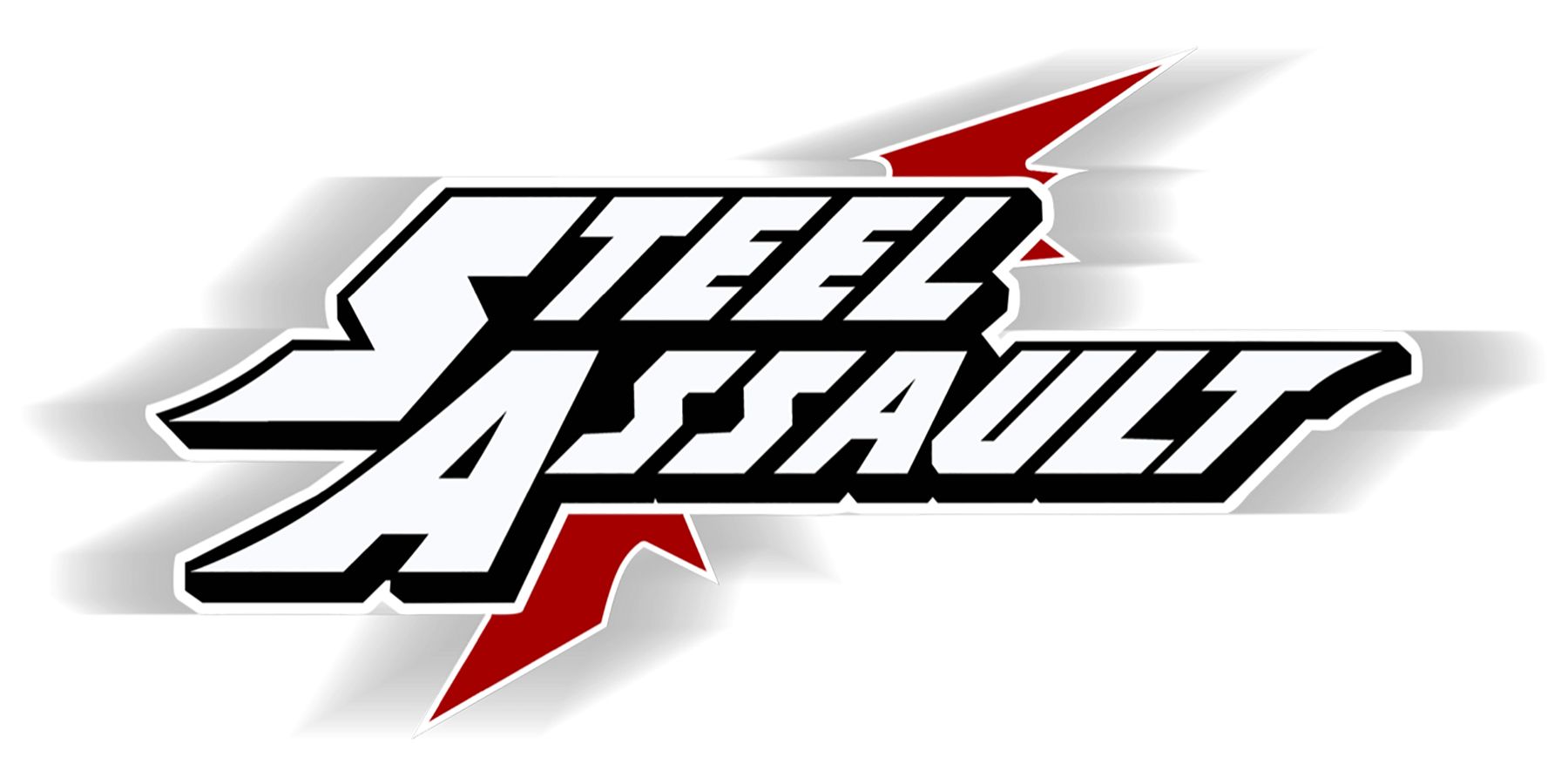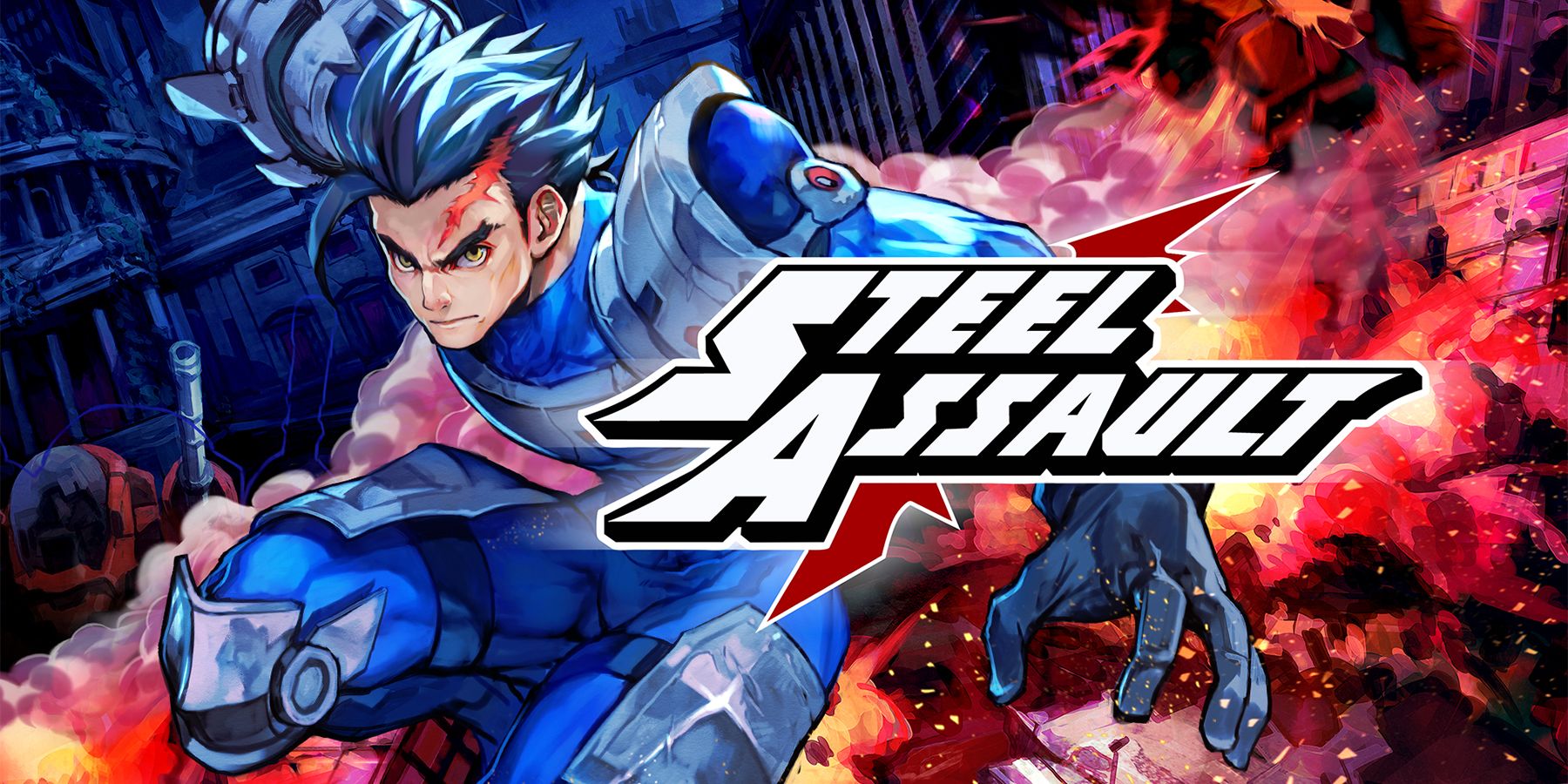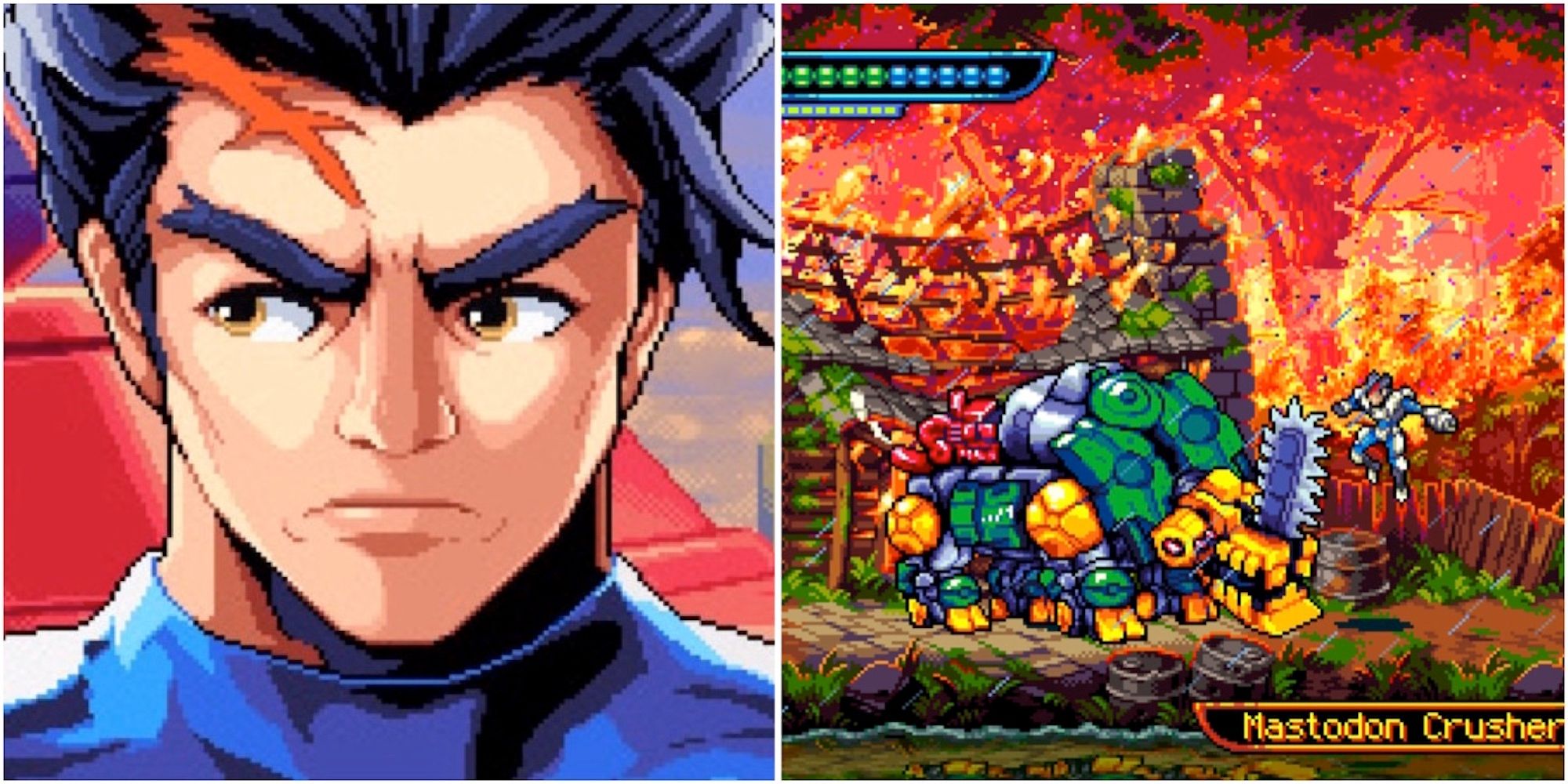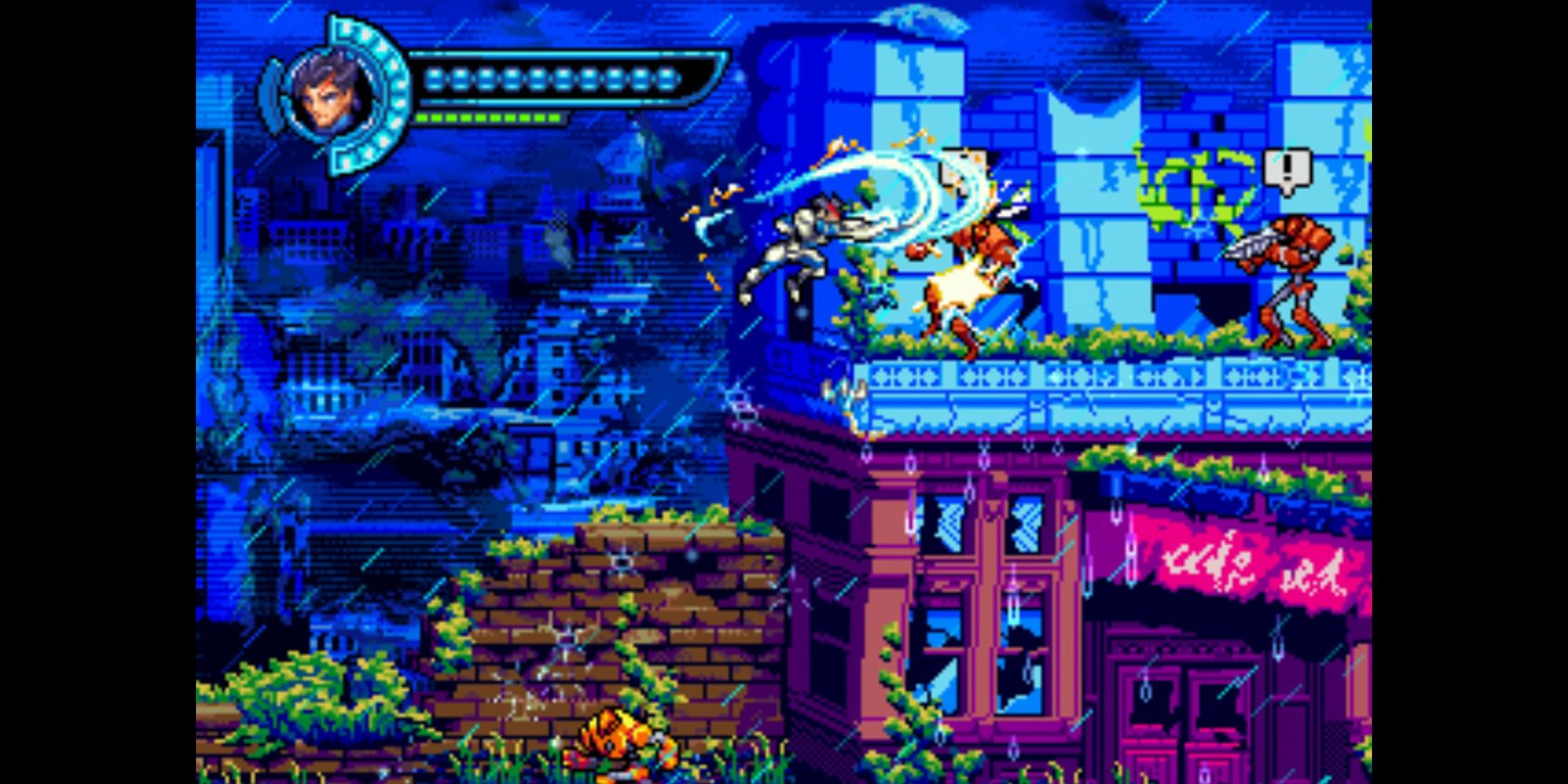The retro-inspired arcade whip-em-up Steel Assault ziplined onto Steam and Switch late in September, earning a favorable response from critics and players alike. The game's plethora of influences include modern post-apocalyptic movies, classic 80s films, arcade run 'n guns, obscure platforming titles, and Castlevania. Gamers looking for a challenging sprint down memory lane, or those who simply want a frenetic, 2D action platformer should keep an eye on the indie title and developer Zenovia Interactive.
Game Rant sat down with Steel Assault's lead developer, Sri Kankanahalli, to discuss everything from the game's dual soundtracks to the artistic development challenges posed by the COVID-19 pandemic. The following transcript has been edited for brevity and clarity.
Game Rant: Can you introduce yourself and share your favorite, classic 2D side-scroller?
Sri Kankanahalli: I’m Sri Kankanahalli, creative director at Zenovia Interactive. We just released Steel Assault for Switch and PC, which is an intense, side-view action game. As far as classics go, my favorites are Metal Slug, Castlevania: Bloodlines, and Contra: Hardcore. Oh! And Mystic Warrior for arcades.
Q: How would you describe Steel Assault to gamers who know nothing about it?
A: It’s an action packed retro-side scroller, which basically takes Castlevania’s mechanics and amps them up to eleven. Think of it as the fastest Castlevania game ever. That was the intention. It’s all about fighting lots of enemies, tackling lots of bosses, and action that doesn’t let up.
Q: Steel Assault launched on September 28th. Are you pleased with the response from audiences so far?
A: Yeah! We’ve gotten a really good response. A lot of reviewers liked it. A lot of streamers seem to like it. The only complaint that we’ve gotten is that the game is too short, but that’s basically by design. We were shooting for arcade-standard length, and the game is about as long as the first Metal Slug. It’s been really nice. People all over the world have been playing it, and that’s very gratifying.
Q: Steel Assault's trailers show off shades of Bionic Commando, Contra, Metal Slug, and other classic run 'n guns. You’ve also mentioned Castlevania as a key influence. What are some other influences — games or otherwise — that shaped the title?
A: I would say those are the main games that inspired us in terms of structure and mechanics. In terms of settings, we weren’t inspired by games, as much as post-apocalyptic movies like I Am Legend and Children of Men. Also, The Last of Us, the game.
Q: It's rare to encounter original movement mechanics in modern 2D games, but Steel Assault's zipline is a breath of fresh air. What can you tell us about its inspirations and development?
A: So it was an idea suggested to me by the original artist for the game, a guy named Daniel Garcia. And I think he got the idea from Tim Burton’s Batman movie from the 80s. There’s a scene where Batman uses a similar mechanic to rescue Vickie Vale from the Joker. That’s where we got it from. But after I programmed the mechanic, we learned that there are a couple classic games that use this mechanic as well.
There’s a game called Roc’n Rope by Tokuro Fujiwara, the guy who made Ghouls N’ Ghosts, if you’re familiar with that title. It was one of his first games. There’s also a Konomi game called Miracle of Almana. It was an NES game that features similar mechanics where you are an Indiana Jones-like explorer. And playing those classic games definitely helped, to some degree, to flesh out this mechanic.
Q: Most 2D side-scrollers feature large arsenals of ranged weaponry, but Taro seems to rely on fisticuffs, his energy whip, and the zipline, with a few exceptions for vehicular shooting sequences. Why did you decide to take a more up-close and personal, Castlevania approach?
A: First of all, I felt like this wasn’t a subgenre that had been pushed to its limits. Second, at the time, I didn’t have any new ideas that suited run ‘n guns. I didn’t want to just remake Contra, or do Metal Slug again. I wanted to make something new, with new characters, and some new mechanics as well. And it felt like we had more to add to close-up action than the traditional ranged action formula. For example, you can also use your whip to cancel enemy bullets, which is a feeling you can’t really get in a traditional run ‘n gun... unless you give your player an energy sword or something.
Q: Other than vehicles, what sort of power ups and pickups will players encounter?
A: Right now we have two basic power-up types; you have a shield, which basically just does what it says; it blocks you from hits for a little while. We also have an electric weapon that upgrades the range of your whip. It makes electricity come off the tip of your whip, going in different directions which can electrify enemies. And both of these weapons tie into the game’s sub weapon system, where you punch enemies up close to gain energy for your power ups. It is similar to Castlevania’s sub-weapon system, though instead of having a different backup weapon, the power ups are extensions of your whip.
Q: How many levels are there in a normal playthrough of Steel Assault?
A: There are five total. Each level has anywhere between four and five sub stages, at least one or two mini bosses, and one boss.
Q: Do you have any pro-tips for new players?
A: I would say: use the slide. When you use the slide, you are invulnerable for a certain amount of time. So if you can’t figure out how to get past a certain enemy, or navigate a certain bullet pattern, or what have you: try sliding. Also, don’t be afraid to use the zipline in creative ways, to gain altitude or get the drop on an enemy.
Q: The game's Steam page describes Taro Takahashi's journey as a mission of revenge. Can you tell us a little more about the main character, and Steel Assault's story?
A: Sure! The main character is Taro Takahashi. The backstory of the game is that there was another world war between the US and China, and the US lost…pretty badly. So in the ashes, this dictator, Magnus Pierce, has taken over. It’s basically a reign of terror. He orders a government purge of everyone who opposed his rule, and Taro’s parents were among those officials. And that’s where he got the scar on his head from—escaping that purge as a child.
Taro joins the underground resistance, the Daybreak resistance, after being recruited by Hans, who is the older man who is talking to you on the comm. He is Taro’s commander. And what starts out as a simple reconnaissance mission becomes a last ditch effort to stop Magnus Pierce’s plans and cripple his regime.
Q: When designing retro games, it can be very hard for a modern title to live up to gamers' fond memories of the classics because they become larger than life. When designing Steel Assault, how did you appeal to classic arcade action without things feeling dated?
A: When you make a title like this—that is meant to evoke the classics, nostalgia, and retro vibes—the challenge really is that you aren’t competing with those classic games. If I downloaded Shinobi for Megadrive, and played it today? That’s not what we’re competing with. We are competing with what gamers imagined that game at the time to be when they were little kids, or like, eight or nine. And you’re right that they do become larger than life.
So I did a couple things. First of all, I put in an Arcade Mode and a Hard Mode, which I think are more in line with what those games were actually like—just no holds barred challenges. But I also included easier modes for people who either aren’t used to that level of difficulty, or just don’t want to deal with it anymore.
As for things feeling dated…. It's an interesting question, because part of the appeal of the game is that it feels a bit dated. The 16-bit style and pixel art. But we did upgrade the pixel art to resemble 32-bit layers on levels, with lots of effects and details in the backgrounds. We used more animation frames than you'd see in a classic game. So we did try to modernize the look, somewhat.
Q: Who did the audio for Steel Assault, and what inspirations did they draw from?
A: There were two main composers for Steel Assault. The first was Joseph Bailey who is based in London. He’s a really talented guy, who did the soundtrack for Devil Engine, which is a shooting game — one of the best shooting games to come out in recent years, in my opinion. I think he was inspired by soundtracks from traditional Japanese shooting games. He was also especially inspired by a series called Thunderforce, which was a series of shooting games that came out for the Sega Megadrive, and Sega Saturn. In particular, the series was noted for its audio, and its kickass metal/hard rock soundtracks by Hyakutaro Tsukumo.
The other composer was a guy named Luke McQueen, and he composed a couple of the songs, but his main work was the arranged FM audio soundtrack. Steel Assault actually has two soundtracks. The first is the regular sound you hear in game. Synth metal/rock. And the other soundtrack is designed to be something you could actually put on a Sega Genesis chip, which you can enable in the options. So he was obviously inspired by a lot of Sega Genesis games. Composers like Yuzo Koshiro who did Streets of Rage.
Q: Steel Assault's graphics were specifically designed to evoke the feeling of an arcade game running on a CRT monitor. Can you describe the challenges in achieving that look?
A: So, the CRT filter is something we spent a lot of time on. I think it’s definitely a really good filter. Especially if you turn on the Bilinear filtering. When it comes to pixel art and all the techniques associated with it, like Dithering and Color Bending and so on...they were originally designed for CRT monitors, and those techniques are still in use today. So designing pixel art for a simulated CRT is just the same as designing pixel art, in my view. I think even modern games could benefit from CRT filters to bring out qualities that wouldn’t be there otherwise.
Q: Can you tell us who your pixel artists were?
A: We had quite a few artists working on this game, based all around the world. It really was an international production. Our main character artists were Walter Samperi, based in Italy, a guy named Raul Vivar, who is based in Spain and who worked on the indie game Blasphemous. And we worked with Eric Quiroz, who is based in Texas. We also had Japanese artists working on the game as well. A lot of people did end up coming and leaving the team as time went on, either due to COVID, or workload from other projects, and other various factors that affect freelance artists.
Q: What were the greatest challenges you encountered during development?
A: Yeah, the greatest challenge was maintaining a cohesive style and art direction throughout the entire process. Art was definitely the biggest challenge by far. On programming level, the game wasn’t too intense. In terms of music and audio assets, we pretty much had the same composing team throughout—the same two guys, and I did a little bit of the music myself, and that was pretty much it.
Q: Were you forced to cut any levels or features from the final game, and if so, can you describe them?
A: Yeah, there were a couple things that we had to cut. For example, the second boss of the game, you're fighting him on this battleship, high in the clouds, and he’s in this kind of snake-like mecha that is coiled around the ship and firing beams at you. And at the end of the bossfight he crashes the ship, and right now, that is the transition to the next stage. But originally, we wanted an extended sequence where the player is skydiving with the boss, avoiding one last round of attacks, but on a design level, we couldn’t really make it work.
Our third boss is a transforming robotic enemy. His first phase is like a phoenix-type creature, followed by a lion-like creature. And originally, we wanted to have two more phases with that boss but we couldn’t get all the art in time. Other than that? Just a couple minor things. We wanted a couple more sections to the final level, and a couple more attacks for enemies. But the bosses are the two big ones in my opinion.
Q: An arcade-inspired title like Steel Assault seems like a natural fit for co-op. Are there any plans of implementing multiplayer down the road?
A: Co-op wouldn’t be an easy task, for sure. It would involve restructuring the game’s entire engine, and it would involve networking challenges. I will say, for our next title, whatever it may be, co-op is definitely a priority. For Steel Assault? I don’t think it’s likely in the near future.
Q: What is next for Zenovia Interactive and Steel Assault? Are you planning on DLC? A sequel? Something else entirely?
A: We can’t say yet. We just released Steel Assault, so we’re still figuring it out. DLC...well. What I will say is this: everything is possible and nothing is confirmed. [Laughing]
Q: Is there anything else you would like readers to know about Zenovia Interactive, Steel Assault, or things in general?
A: All I can say is: I hope you like the game, I hope you enjoy the game. We put a lot of hard work into Steel Assault. A lot of tears. I really hope that hard work shows and gamers resonate with it.
[End]
Steel Assault is available now for PC and Switch.




